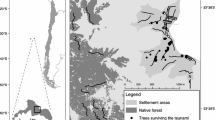Abstract
Population trends of the brackish water damselfly, Mortonagrion hirosei were studied for 4 years in the reed community artificially established for conservation of this endangered species. Because of difficulty with mark-and-recapture experiments on this small damselfly with weak wings in the large dense reed community, census counts using the line transect method were performed to estimate the population parameters. The reed rhizomes were transplanted in January of 2003. A few adults immigrated to the community in the flying season of this year, but they were restricted near the original habitat. The number of adults throughout the flying season was estimated at 1,000. In 2004, the population included both the immigrants from the original habitat and the emergences from the established habitat, and the total population was estimated at 10,000, and the daily density in peak flight season was 20% that in the original habitat. An estimated 23,000 individuals were found all over the established habitat in 2005. In 2006, the estimated number of adults in the established habitat was 45,600, and the population density increased almost equal to that in the original habitat. Therefore we can conclude that the damselfly had settled in the established habitat.



Similar content being viewed by others

References
Corbet PS (1999) Dragonflies: behavior and ecology of Odonata. Cornell University Press, New York
Foster SE, Soluk DA (2006) Protecting more than the wetland: the importance of biased sex ratios and habitat segregation for conservation of the Hine’s emerald dragonfly, Somatochlora hineana Williamson. Biol Conserv 127:158–166
Higashi T, Watanabe M (2006) The conservation ecology of the brackish water damselfly, Mortonagrion hirosei—colonization process and the population dynamic of adults in the newly established habitat. In: Abstracts of papers seventeenth international symposium of odonatology, pp 24, Hong Kong, China
Hioki Y, Handa M, Okajima K, Urato H (2003) Avoiding extinction of local population of Coenagrion terue by continuous monitoring. Tech Rep Landscape Archit (2):156–159 (in Japanese)
Hirose M, Kosuge T (1973) Life history of Mortonagrion hirosei in Hinuma pond, Ibaraki prefecture. The Nature and Insects 8(4):2–6 (in Japanese)
Inoue K, Tani K (1999) All about dragonflies. Tombo Press, Osaka (in Japanese)
Iwata S, Watanabe M (2004) Saline tolerance of young zygopteran larvae inhabiting the emergent plants community established in estuaries. Jpn J Entomol 7:133–141 (in Japanese with English summary)
Kanazawa I (2001) Hinuma-Itotombo. Osaka-no-Rekishi-to-Bunkazai (7):40–44 (in Japanese)
Kefford BJ, Zalizniak L, Nugegoda D (2006) Growth of the damselfly Ischnura heterosticta is better in saline water than fresh water. Environ Pollut 141:409–419
Matsu’ura S, Watanabe M (2004) Dynamics of reed community artificially established for conservation of the endangered damselfly Mortonagrion hirosei and odonate larvae inhabiting the community. Jpn J Conserv Ecol 9:165–172 (in Japanese with English summary)
Matsu’ura S, Watanabe M (2006) Growth of reed community artificially established for conservation of the endangered damselfly Mortonagrion hirosei. Ann Res Report Mie-Prefecture Environ Conserv Agency 12:1–8 (in Japanese)
Mimura Y, Watanabe M (2006) The conservation ecology of the brackish water damselfly, Mortonagrion hirosei—population dynamics of adults in the original habitat. In: Abstracts of papers seventeenth international symposium of odonatology, pp 36, Hong Kong, China
McLusky DS, Elliott M (2004) The estuarine ecosystem. Oxford University Press
Nishu S (1997) Life history and habitat of Mortonagrion hirosei. Midori-no-Tokuhon 43:811–816 (in Japanese)
Someya T (1998) The present state of the damselfly, Mortonagrion hirosei. Nature Insects 33(10):4–8 (in Japanese)
Southwood TRE, Henderson PA (2000) Ecological methods, 3rd edn. Blackwell Science
Uchida T, Andoh A, Maruyama J (1999) Studies on the efficiency of clonal shoot production using lateral bud of culm and rhizome of common reed (Phragmites australis (Cav.) Trin.). J Jpn Soc Reveg Tech 25:13–24 (in Japanese)
Thomas CD, Abery JCG (1995) Estimating rates of butterfly decline from distribution maps: the effect of scale. Biol Conserv 73:59–65
Watanabe M, Mimura Y (2003) Population dynamics of Mortonagrion hirosei (Odonata: Coenagrionidae). Int J Odonatology 6:65–78
Watanabe M, Mimura Y (2004) Diurnal changes in perching sites and low mobility of adult Mortonagrion hirosei Asahina inhabiting understory of dense reed community (Zygoptera: Coenagrionidae). Odonatologica 33:303–313
Watanabe M, Iwata S (2007) Evaluation of line transect method for estimating Motnagrion hirosei Asahina abundance in a dense reed community (Zygoptera: Coenagrionidae). Odonatologica 36:173–191
Yamane S, Kojima S, Sato S (2004) Preparation of a substitute habitat for the damselfly, Mortonagrion hirosei (Odonata: Coenagrionidae) at the construction site of Tone-Kamome Bridge over the Tone River. Bull Ibaraki Nat Mus (7):45–61 (in Japanese with English summary)
Yutani K, Asaeda T (2002) Effects of rhizome age of Phragmites australis on the characteristics of rhizome resource storage. J Jpn Soc Water Environ 25:685–688 (in Japanese with English summary)
Acknowledgments
We thank the staff of Tamano Consultants Co., Ltd. and the Ise Branch of the Mie Prefectural Government. This study was supported in part by the AEON Environmental Foundation. Thanks are also due to Prof. Malcolm Fitz-Earle at Kyoto University for editing the manuscript.
Author information
Authors and Affiliations
Corresponding author
Rights and permissions
About this article
Cite this article
Watanabe, M., Matsu’ura, S. & Fukaya, M. Changes in distribution and abundance of the endangered damselfly Mortonagrion hirosei Asahina (Zygoptera: Coenagrionidae) in a reed community artificially established for its conservation. J Insect Conserv 12, 663–670 (2008). https://doi.org/10.1007/s10841-007-9108-3
Received:
Accepted:
Published:
Issue Date:
DOI: https://doi.org/10.1007/s10841-007-9108-3



